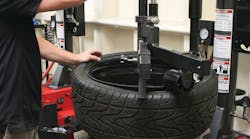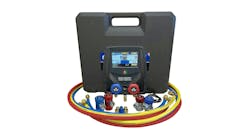Up there with oil changes and brakes, changing and repairing tires is the most common job a light duty fleet maintenance facility will handle. A good tire changer will, with regular maintenance and some repairs, last for many years. However, changes in fuel economy regulations, vehicle types and trends as it pertains to rim size and composition have had an effect on tire service.
The days of easy steel rims and regular valve stems are fast disappearing. Fleets these days have "soft" aluminum rims, tires with stiff sidewalls and TPMS (tire pressure monitoring system) valve stems that if serviced improperly can break. Not surprisingly, times are a changing in the tire changing world as well. Keep this in mind when shopping for a new tire changer.
110V OR 220V?
For years, many shops have been working with 110V and 220V tire changers, not knowing that there is not a huge difference between the two. Both different types of machines consume the same wattage, buta 220V machine will run at half the amperage.
Simply put, with half the voltage available to a 110V machine, the amperage is doubled. Many shops will purchase a 110V machine, because it will spare them a phone call to the electrician.
According to Jeff Kritzer, senior vice president of sales and marketing for BendPak, when a tire is properly secured, there is one clear differentiator between 110V and 220V machines.
Bendpak (www.bendpak.com) is a global leader in automotive repair-relate capital equipment including lifts, oil filter curshers and tire and wheel service equipment.
"One advantage a motor running on higher voltage would have is starting under load," he notes. "When servicing heavy wall truck tires or stubborn performance tires and wheels, the turntable may tend to stall. A machine running on 220V will have a better chance of restarting and continuing after a stall."
For this reason, 220V machines are becoming increasingly important. Most new light duty vehicles come with aluminum rims, all of them come with TPMS sensors and an increasing amount come with run-flat tires.
Oftentimes, installing these items requires putting an assist arm on the far side of the tire and depressing the bead in between the rim and the mounting head with a tire bar. Then, the user turns the tire 30 degrees or so, readjusts his tire bar and repeats the process.
When installing the tire, even when the rim is properly secured and the tire has plenty of lube on the bead, the turntable may stop turning if the technician takes his foot off the pedal. Sometimes, he will need to do this if the tension from the bead pulls the mount head into the rim, which causes damage. Other times, he may stop to adjust his tire bar in order to avoid tearing the bead.
No matter the reason, a 220V machine with the appropriate assist arms help prevent this and damage to the rim, because it allows the user to get the turntable moving even as the bead gets tighter. This enables the technician to make adjustments without fearing that the turntable won't b able to be made to rotate afterwards. It also decreases the need for another technician to help spin the tire as the turntable struggles to rotate. In this way, a 220V machine is safer and more efficient.
SPECIFICATIONS AND ACCESSORIES
Fuel economy requirements and vehicle users desiring large rims with low profile tires has affected the kind of tire work fleets require. It is wise to look for a tire changer with a large turn table and a tilt-back mechanism in order to not only accommodate the tires that are already in the marketplace, but to be adaptable to the larger rims and thinner tires that are yet to come.
"For a fleet operation servicing mostly passenger vehicles and light duty truck tires and wheels, a standard swing-arm or tilt-back style changer with a wheel clamping range up to 24" should be adequate," says Kritzer. "Be sure to check your specific requirements before choosing the appropriate machine."
More vehicles, particularly electric vehicles and hybrids, are being equipped with low-rolling-resistance tires in an effort to increase fuel efficiency. These tires have stiffer sidewalls and are made of a harder rubber compound, making them more difficult to change.
"Having a tire changer with power-operated assist tools will play a pivotal role in making sure these (low rolling resistance) tires are most effectively serviced," says Kritzer. "These same tires will need the use of multiple assist arms in order to prevent scratching the rim and tearing the bead."
"If you're running a modern tire service department today, having at least one tire changer with assist tools or helper arms is almost essential," he adds. "Today's assist-ready machines feature a multitude of devices that improve operator efficiency, safety and minimize damage to expensive wheels.
One of BendPak's most popular assist tools is a traveling drop-center tool "that holds stubborn sidewalls in the drop-center area of the wheel when mounting," notes Kritzer. "Lower bead lifting discs are also helpful tools that can be used to unseat stubborn lower beads or to elevate tires for proper tool placement."
These accessories essentially reduce the manpower and effort necessary when changing a tire. For example, a bead assist roller near the mount head reduces the need for such techniques as adjusting the bead with a tire bar between the rim and mounting head. This technique can sometimes fail and result in damage to a tire.
Generally, fleets are less picky about the care taken with their rims than regular consumers are. However, it is important to keep in mind that it is becoming increasingly necessary just to have these accessories to simply get the job done.
ADDITONIAL CONTEMPLATIONS
There are a few other considerations before purchasing a tire changer.
One is that some technicians are having an increasing amount of trouble breaking beads on tires with the tire changer's shovel. This problem should only increase as sidewalls become stiffer.
While some technicians blame their machine, it is possible that they are simply not breaking the bead on enough different points of the tire or that the shop's air compressor is underpowered.
"Typical tire changers require that you have an air compressor capable of at least 150 psi," says Kritzer. "When selecting an air compressor a best practice is to have an air compressor at least two times larger than the CFM required for the largest air tool or machine in your shop."
The advent of "touchless" tire changers has also complicated things. A touchless tire changer does make it easier to change a low profile, run flat tire on a 22" rim, but the machines require training to use. These machines offer marked efficiency improvements, as they lift and set up heavy rims on their own and do not require the operator to frequently bend down. They will also be the most adapaible to future changes in tire service.
However, all of this comes with a price, as touchless tire changers tend to be the top-of-the-line offered by the several tire machine companies to date.
Nonetheless, there are still large fleets of USPS trucks, minivans and taxis out there that still use simple steel rims. Shops that work on these vehicles typically will require a tire changer with much less frills.
Beginning in 2007, every vehicle with a GVWR less 10,000 lbs has a TPMS sensor of some sort. This means that even when servicing vehicles with steel rims there are risks involved with an "old school" tire changer.
"For fleet operations that are accustomed to steel wheel services only, center post tire changers would be an option," Kritzer notes. He warns that without any upgrades or accessories "there's a high probability (such a machine) would damage aluminum wheel or TPMS equipped wheels."
FINISHING THOUGHTS
Ultimately, the tire changer right for your shop will have to be able to work on today's tires while offering years of use. Be sure to purchase a machine from a company that will warranty parts and labor on the machine, as well as offer responsive technical service in between.
Many minor issues with tire changing equipment can be fixed by a technician in the shop with the help of a tech-line. Before committing to a large purchase, try calling the company's phone number. Speak with customer service and tech help in order to get a firm idea that the company is responsive and prepared to handle inquiries.
Lastly, try to find out who in the area would service the equipment if and when it fails. After all, uptime is absolutely critical.
Making all these considerations will help you make the right decisions when selecting a tire changer. No piece of capital equipment in your shop other than perhaps the lifts and air compressor might be used more.




